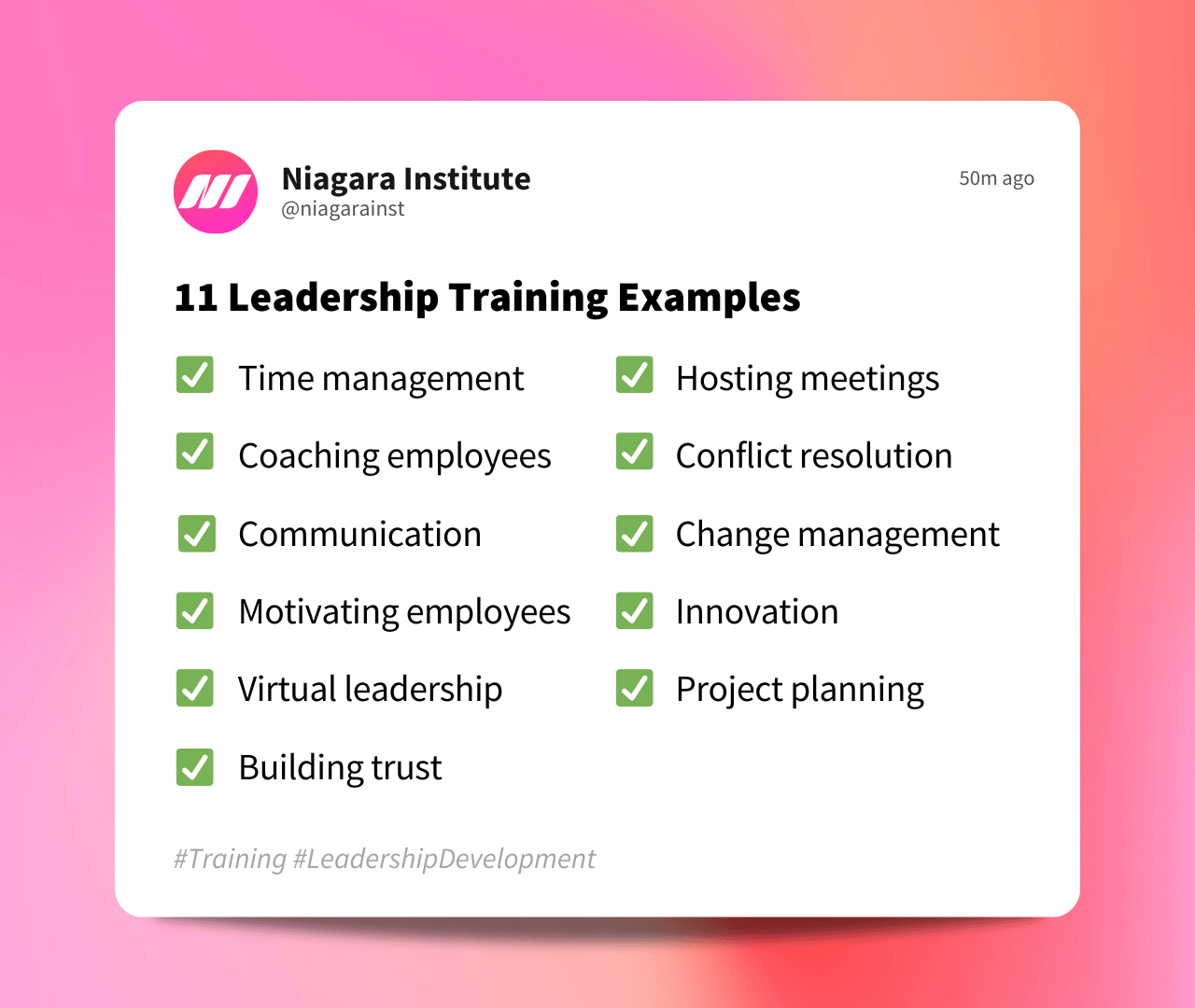5 min read
The Ultimate Free Leadership Training for Managers
Are you new to management, looking to upgrade your leadership skills, or sourcing leadership training for your employees? If the answer is yes,...
5 min read
 Michelle Bennett
:
Aug 1, 2023 5:00:00 AM
Michelle Bennett
:
Aug 1, 2023 5:00:00 AM

Leadership training is a two-way street. Not only do organizations need to be willing to invest time and money into training their leaders, but leaders themselves need to be willing and ready to actively participate in their own development whenever the chance arises.
Case in point; in Training Magazine’s 2023 Annual Leadership Development Survey, the majority of organizations (70%) said they expect their leaders to accept personal responsibility for their own development.
However, this does not mean organizations are off the hook. According to the study, what separates high-performing organizations from low-performing ones is the level of support they provide their leaders in accepting this responsibility.
Remember that while funding and financing training is one way to support leaders, it’s not the only way. Often, leaders will be reluctant to spend a day, let alone a week, away at a training program out of fear that their workload will pile up or their team will be left to fend for themselves. In this case, support can mean offering additional resources and oversight for the duration of the training program so that the leader can solely focus on the task at hand - developing their leadership skills.
Whether you’re a solitary leader looking for a program for yourself or an organization seeking out training for a group of leaders, you might be trying to get a sense of what topics will be most worthwhile. If so, you’ll find this article useful as it breaks down 11 examples of leadership training topics and the importance of each. Let’s start by reviewing the 11 leadership training examples:

If you’re wondering why time management of all things tops this list, the answer is simple. In order to lead others, you must first be able to manage yourself. It’s called self-management, and time management is a huge component. As a leader, it can feel like everyone needs something from you, and you’re being pulled in a million different directions. When this happens, you need to have the skills and tools that will allow you to prioritize your tasks, optimize your time, and organize your schedule to maximize your productivity. Only when you have those skills and tools will it feel like you can come up for air and make some tangible headway on your mandate.
Since 2018, Training Magazine has asked respondents of their Annual Leadership Development Survey to identify their organization’s top five most important leadership skills. Developing and coaching employees has taken the number one spot for five out of the past six years. It’s not just organizations that value this skill; employees do too. This was proven in a Gartner study which found that employees who believe their direct leaders have strong coaching skills are 20% more likely to stay with their current company, 40% more engaged with their work, and willing to exert up to 38% more discretionary effort. Clearly, this is one leadership training example that is well worth investing in.
You’d be hard-pressed to find a list of leadership training examples that don’t include communication and for a good reason! Communication has the power to make or break your effectiveness as a leader. Fortunately, bestselling leadership communication training programs, such as Niagara Institute’s ever-popular Speaking as a Leader, are designed to equip leaders with practical knowledge, tools, and techniques they can apply immediately to their everyday lives. When they do, those leaders will be more capable, confident, and compelling communicators that employees listen to and follow not because they have to but because they want to.
No one feels motivated 100% of the time, not even high potentials or star performers. It’s something leaders have to learn how to deal with and the faster you do, the better it will be for your team and the results you are all responsible for delivering. This is where leadership training comes in. While you can learn to motivate employees with time and experience, a training program on the topic can accelerate the process and make you more effective in less time. In situations where you’re dealing with concerning levels of demotivation and low engagement, training can give you actionable tips, ideas, and techniques that you can use to start motivating employees right away.
As the name suggests, virtual leadership is defined as leading people virtually or online. In a post-COVID world, where many leaders and employees are working either fully-remote or partially-remote positions, this is one leadership training example that is a must-have. In fact, in 2022, The Conference Board put 100 “early-career leaders” from 30 organizations through a training program focused on virtual leadership. They found that equipping these leaders with the skills to manage virtual teams could “improve productivity, quality, safety, employee engagement, and customer satisfaction, among other business performance indicators.” Not to mention, at the end of the program, 68% of leaders surveyed said that they had improved in their selected measures, with the top selected measures being employee engagement, employee experience, and productivity.
In a 2020 study conducted by The Workforce Institute, over half of the employees who participated said that trust directly impacts their daily effort (68%), sense of belonging in the workplace (64%), career choices (58%), and mental health (55%). These statistics alone highlight just how important building trust is for people leaders. However, if that’s not enough to convince you it should be prioritized in your leadership development plans, consider the fact that Great Place to Work has surveyed more than 100 million employees over 30 years and has consistently found that trust is at the heart of great workplaces. It’s why they established the Trust Index, which organizations now use to benchmark themselves against the Best Workplaces in the world.
Leaders can’t just show up at meetings they're hosting, wing it, and hope for the best. That’s how you end up with frustrated employees who see meetings as a waste of time. To avoid this, leaders need not only the tools needed to put together an agenda, shut down tangents, unite members around a common goal, and create accountability for the defined action items but also the confidence to do so. Fortunately, leaders can learn everything they need to about hosting meetings with the help of leadership training that is specifically designed for their needs and to build their confidence.
In leadership, it’s not a matter of if a conflict will happen but when. Conflict in the workplace is inevitable, and ignoring it, just hoping it will go away on its own, isn’t an option, particularly if the conflict is severe enough to risk putting productivity, the customer experience, and team culture in jeopardy. While it might not ever be easy or pleasant to do so, it can become more manageable with the help of conflict resolution training that is designed specifically for those who manage people.
We live and work today in a VUCA environment, one that is volatile, uncertain, complex, and ambiguous. This can cause a great deal of stress as people don’t know what to expect or how it will affect them. Fortunately, leaders are in a position where they can reduce their employee's stress and subsequent resistance to change, thus making the change more likely to succeed. The key is to develop change management skills as early as possible and have tools at the ready so that when the time comes to change, leaders feel comfortable with the things they have learned and are ready to apply them in real-life scenarios.
Innovation might be one of the more underrated leadership training examples on this list, but that does not mean it’s any less important, especially today. In today’s workplace, you cannot afford to be static. Leaders and their teams must always be challenging themselves to improve upon what’s already working, pushing the boundaries of what’s possible, and looking for opportunities to innovate. With the help of leadership training in this area, leaders can learn how to create psychological safety, motivate employees, offer support, and remove roadblocks, which will make it more likely for innovation to flourish.
Last but not least on this list of leadership training examples is project planning. In a 2019 study featured in the International Journal of Project Organisation and Management, leadership was cited as one of the top reasons why projects fail to meet their goals. Fortunately, investing in a leader’s project planning and management skills can help reduce the chance of failure for all involved. In fact, those who have these skills aren’t just capable of delivering projects on time and on budget; they’re also able to set realistic goals, mitigate risks, optimize resources, prioritize competing tasks, and foster collaboration among employees.

5 min read
Are you new to management, looking to upgrade your leadership skills, or sourcing leadership training for your employees? If the answer is yes,...

7 min read
Between inflation, broken supply chains, political turmoil, digital transformation, and financial instability, employees and leaders are under...

12 min read
Whether you’re early in your career or have many years of experience, mastering leadership skills is not just a desirable trait; it’s necessary for...